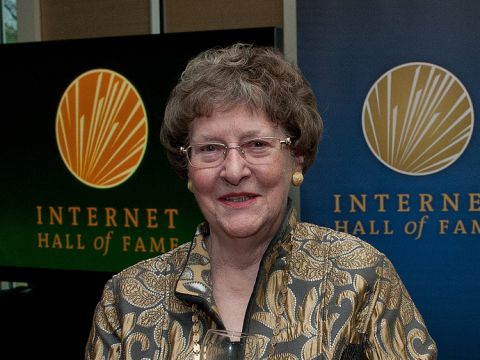From 1972 to 1989, Elizabeth “Jake” Feinler ran the Network Information Center at the Stanford Research Institute in Menlo Park, California — the place that oversaw the use of internet addresses before the arrival of commercial outfits such as GoDaddy and Network Solutions. If you wanted a domain name, you came to Jake.
The NIC was also the place that published the documentation and directories for the internet — well before it was called the internet. The Stanford Research Center, or SRI, was one of the original nodes on the ARPAnet — a network backed by the US Department of Defense that connected various research centers across the country — and in building the NIC and running it for 17 years, Feinler was among a small group of researchers who bootstrapped this government network into something that would one day connect one third of the world’s population.

Earlier this year, Elizabeth Feinler was inducted into the inaugural class of the Internet Society’s (ISOC) Internet Hall of Fame, alongside such luminaries as Vint Cerf, Sir Tim Berners-Lee, Van Jacobson, and Steve Crocker. But don’t call her Elizabeth. She has long been known as Jake.
Feinler was born in West Virginia. Her given name was Elizabeth Jocelyn Feinler, and her family called her Betty Jo. But when her two-year-old sister, Mary Lou, called for her, it came out as Baby Jake. The “Baby” was dropped, but the “Jake” stuck. That’s how she signs her emails.
After receiving her undergraduate degree at West Virginia’s West Liberty State College and studying biochemistry at Purdue University in Indiana, she joined SRI. Initially, she continued to work on projects related to chemistry, but in 1972, she was recruited into a new group by Douglas Engelbart, the man who had foretold the future of computing with “The Mother of All Demos” four years before.
In 1968, Engelbart and his SRI group had unveiled NLS — short for “oN Line System” — a creation that paired the world’s first computer mouse with a graphical user interface fifteen years before the arrival of the Apple Macintosh. The group also ran SRI’s connection to the ARPAnet, and after joining the operation, Feinler helped build a new group that would oversee the logistics of running the government network, which had come online in 1969.
As the head of the NIC, Feinler oversaw the distribution of the ARPAnet “white pages” and “yellow pages,” directories of people and services on the fledgling network, as well as the Requests for Comments, or RFCs, the documents that described how the network would actually work. Plus, the NIC ran the network’s central address servers — the machines that told the network where everyone was located — and it was the place you went for new addresses.
“The NIC was like the pre-historic Google,” Feinler says. “People came to us for everything.” Initially, the documentation and directories were distributed on paper, and the group even ran a hotline you could call with urgent questions. But over the years, so much of this moved online as well.
By the late 1980s, central address servers were no longer necessary. Feinler and the rest of the ARPAnet community moved to the domain name system, or DNS, which spreads the same duties to servers across the length and breadth of the network, and this helped lay the foundation for the modern internet. In 1991, two years after Feinler left SRI, its network address duties were farmed out to commercial outfits such as Network Solutions.
Did she see this future coming? She did. But it wasn’t DNS that did it. It wasn’t even the ARPAnet per se. It was NLS. “When you sat down in front of Engelbart’s system,” she says, “you essentially saw what we do today.”